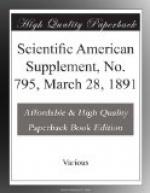The largest definitely ascertainable daily average circulation for one year, in this country, has been 222,745. Only one other daily paper in the world has had more—Le Petit Journal, in Paris, which really, as we understand it, is not a newspaper, but which regularly prints and sells for one sou more than 750,000 copies. The largest American weekly is the Youth’s Companion, Boston, 461,470. The largest monthly is the Ladies’ Home Journal, Philadelphia, 542,000. The largest among the better known magazines is the Century, 200,000. Of the daily papers which directly interest us—those of the city of New York—the actual or approximate daily averages of the morning papers are given by “Dauchy’s Newspaper Catalogue” for 1891, as follows: Tribune, daily, 80,000; Sunday, 85,000. Times, daily, 40,000; Sunday, 55,000. Herald, daily, 100,000; Sunday, 120,000. Morning Journal, 200,000. Press, daily, 85,000; Sunday, 45,000. Sun, daily, 90,000; Sunday, 120,000. World, daily, 182,000; Sunday, 275,000. Of the afternoon papers, Commercial Advertiser, 15,000; Evening Post, 18,000; Telegram, 25,000; Graphic (not the old, but a new one), 10,000; Mail and Express, 40,000; News, 173,000; Evening Sun, 50,000; Evening World, 168,000. The entire circulation of New York dailies, including with those named others of minor importance, and the German, French, Italian, Bohemian, Hebrew and Spanish daily newspapers, is 1,540,200 copies.
Obviously, there is and must be ceaseless, incisive and merciless competition in securing and holding circulations, as well as in the outward statements made of individual circulations to those who purchase advertising space. In this, as in all other forms of enterprise, there are honest, clean-cut and business-like methods, and there are the methods of the time-server, the trickster and the liar.
The vastly greater number of publications secure and hold their clientage by making the best possible goods, pushing them upon public patronage by aggressive and business-like means, and selling at the lowest price consistent with excellence of product and fairness alike to producer and consumer. But of the baser sort there are always enough to make rugged paths for those who walk uprightly, and to contribute to instability of values on the one hand, and on the other to flooding the country with publications which the home and the world would be better without. Every great city has more of the rightly made and rightly sold papers than of the other sort, and the business man, the working man, the professional man, the family, no matter of what taste, or political faith, or economic bias, or social status, or financial plenty or paucity, can have the daily visits of newspapers which are able, brilliant, comprehensive, clean and honest. But all the time, these men and families will have




